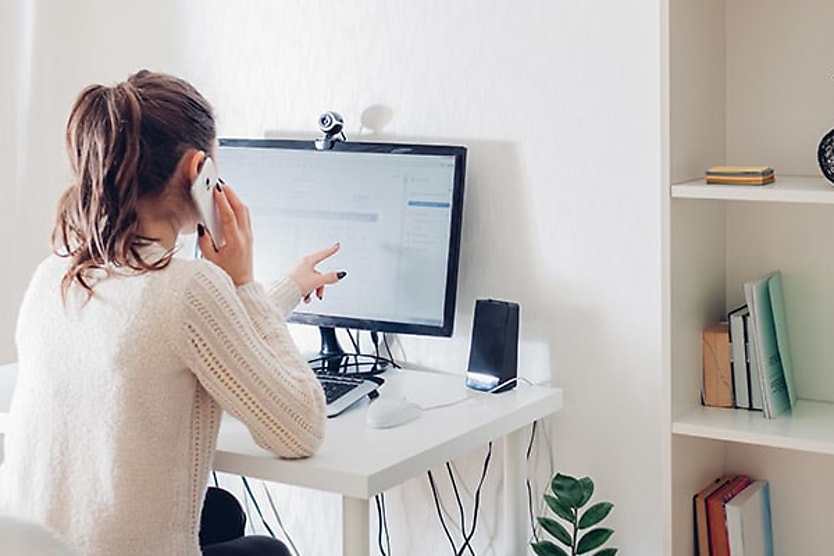
Working from home can leave room for inadequate office set-ups that may have a negative impact on your health and wellbeing.
An article by The Telegraph in the UK stated that the increase in working from home may have resulted in a surge in neck and back pain.
Referencing the Office for National Statistics (ONS) data, The Telegraph noted that in the UK, “some 262,000 people were out of work because of long-term sickness linked to neck and back problems between April and June this year – an increase of 30 per cent from before the pandemic”.
According to the ONS, since 2019, approximately 500,00 more people were “long-term sick” and therefore “economically inactive” in the UK from June to August 2022 (in the region of 2.5 million people). From 2019 to 2022, neck and back complaints are listed as the second biggest increase in causes of long-term sickness.
What the Australian government says
Comcare, the work health and safety branch of the Australian government, published an office safety tool.
The “working from home” option, under the “working areas” tab, provides recommendations to avoid physical and mental health issues. The tool has information for both employers and employees to assist in setting up a workstation, lighting, ventilation, and boundaries to reduce mental strain.
Comcare references include Work Health and Safety Regulations (2011) and Safe Work Australia.
Safe Work Australia has a list of resources to assist with working from home.
Equipment
Australian Sports Physiotherapy published an article outlining their recommended ergonomics for a home office: Home Office Ergonomics in Physiotherapy. Their suggestions relate to the chair, screen, desk and more.
For example: “Chair: Hip, knees and ankles should be at 90 degrees. Ideally, the armrest is lower than the table, and it’s not preventing your chair from moving towards the desk. The best ergonomic chairs are designed with your comfort and health in mind. They offer features like lumbar support, adjustable headrests, back tilt, seat height adjustment, and more to help you find the perfect fit for your body.”
Temperature matters
According to the BBC, living in a cold home has negative effects on your health.
The BBC provided data from the Department of Health that says cold living environments creates an increased risk of cardiovascular disease, respiratory illness, and mobility issues, which could increase the chances of a fall.
The UK Department of Health recognised that “mental and social health’” can also be impacted.
The American Heart Association says that cold temperatures can also increase the risk of stroke.
HR Leader notes different ways to keep a home office warm, to stay cosy during cold weather:
- suitable heating;
- blankets;
- hot water bottles;
- wearing layers; and
- moving around to get the blood pumping.
Hays regional director’s insights
Eliza Kirkby, regional director of Hays, provided her thoughts on what makes a comfortable home office.
“Find a dedicated space that you can use solely as your work zone. By having a separate workspace, you signal to yourself and others that when you are in that area, your workday has commenced. When you finish, don’t be tempted to sit back down in that space until the next day,” said Ms Kirkby.
“While some people find that a noisy office adds to their stress levels, others find they miss the buzz and background noise of an office. If you fall into the latter category, turn on the radio or play gentle background music.”
Ms Kirkby notes that establishing a routine can help prepare you for the day: “Your concentration, productivity and wellbeing will all benefit from regular breaks away from your screen.”
“You can also try the 5-55 rule, which involves spending five minutes out of every hour standing up, stretching your legs and moving – even if you only go to the kitchen for a glass of water,” she said.
Isolation can create feelings of loneliness. Ms Kirkby encourages people to connect as much as possible to ensure you’re still receiving that human element that on-site work provides: “For people who have been working from home for some time, out of sight, out of mind can be a real issue. So, take every opportunity to connect with colleagues and your manager using videoconferencing, chat or online collaboration tools.”
Ms Kirkby added: “Finally, look after your wellbeing and minimise the risk of burnout by setting clear boundaries. Maintain the same hours you would if you were in the office, including your regular finish time. Log off and step away from your designated workspace – and don’t return until the next morning. For many people, it can be tempting to do a little extra at night. However, this could come at the cost of disrupting your sleep schedule and depleting your energy levels the following day.”
Note from the editor: Please note that this article has been prepared for informational purposes only and is not to be construed as advice.
RELATED TERMS
In a hybrid work environment, individuals are allowed to work from a different location occasionally but are still required to come into the office at least once a week. With the phrase "hybrid workplace," which denotes an office that may accommodate interactions between in-person and remote workers, "hybrid work" can also refer to a physical location.
Professionals can use remote work as a working method to do business away from a regular office setting. It is predicated on the idea that work need not be carried out in a certain location to be successful.
Jack Campbell
Jack is the editor at HR Leader.










